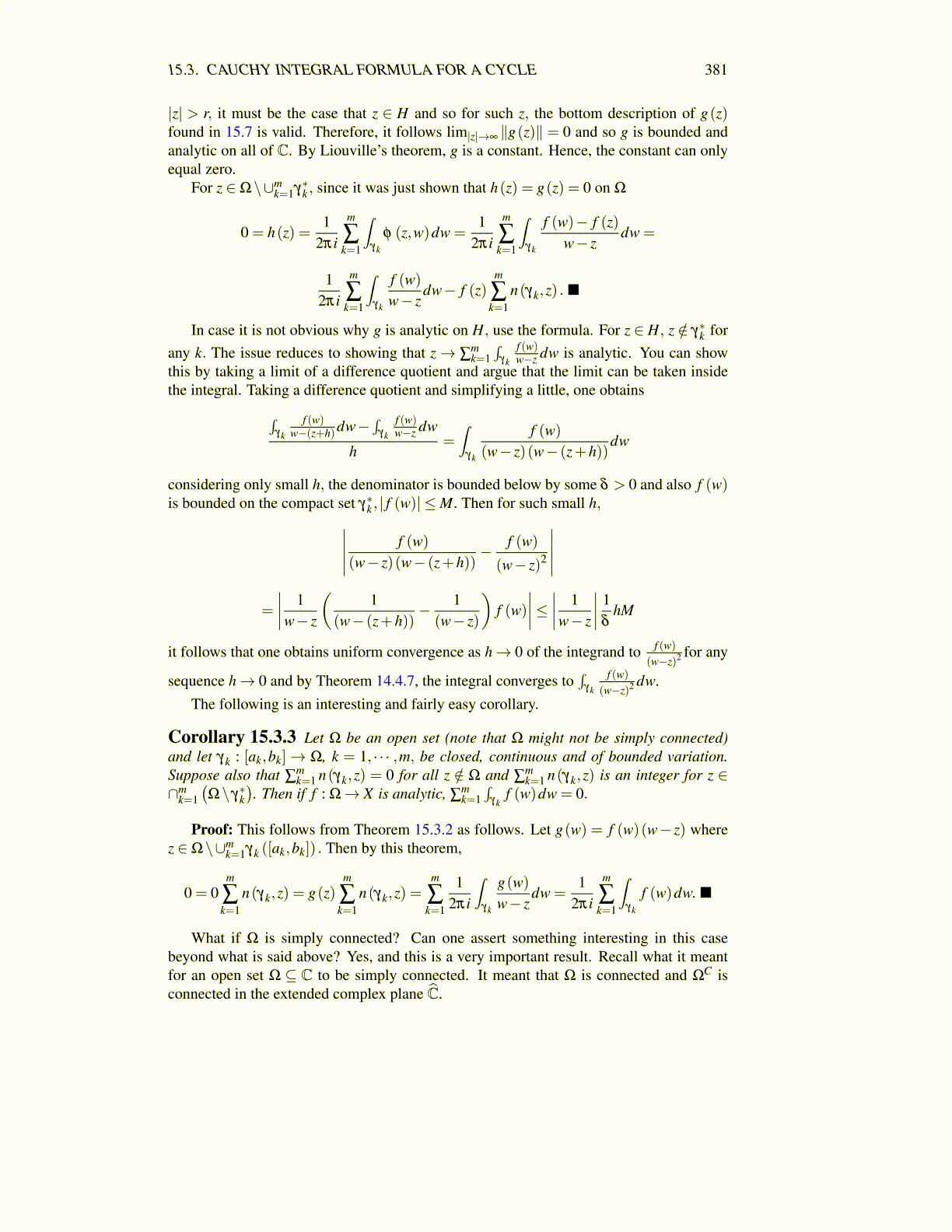
15.3. CAUCHY INTEGRAL FORMULA FOR A CYCLE 381
|z| > r, it must be the case that z ∈ H and so for such z, the bottom description of g(z)found in 15.7 is valid. Therefore, it follows lim|z|→∞ ∥g(z)∥ = 0 and so g is bounded andanalytic on all of C. By Liouville’s theorem, g is a constant. Hence, the constant can onlyequal zero.
For z ∈Ω\∪mk=1γ∗k , since it was just shown that h(z) = g(z) = 0 on Ω
0 = h(z) =1
2πi
m
∑k=1
∫γk
φ (z,w)dw =1
2πi
m
∑k=1
∫γk
f (w)− f (z)w− z
dw =
12πi
m
∑k=1
∫γk
f (w)w− z
dw− f (z)m
∑k=1
n(γk,z) . ■
In case it is not obvious why g is analytic on H, use the formula. For z ∈ H, z /∈ γ∗k forany k. The issue reduces to showing that z→ ∑
mk=1
∫γk
f (w)w−z dw is analytic. You can show
this by taking a limit of a difference quotient and argue that the limit can be taken insidethe integral. Taking a difference quotient and simplifying a little, one obtains∫
γk
f (w)w−(z+h)dw−
∫γk
f (w)w−z dw
h=∫
γk
f (w)(w− z)(w− (z+h))
dw
considering only small h, the denominator is bounded below by some δ > 0 and also f (w)is bounded on the compact set γ∗k , | f (w)| ≤M. Then for such small h,∣∣∣∣∣ f (w)
(w− z)(w− (z+h))− f (w)
(w− z)2
∣∣∣∣∣=
∣∣∣∣ 1w− z
(1
(w− (z+h))− 1
(w− z)
)f (w)
∣∣∣∣≤ ∣∣∣∣ 1w− z
∣∣∣∣ 1δ
hM
it follows that one obtains uniform convergence as h→ 0 of the integrand to f (w)(w−z)2 for any
sequence h→ 0 and by Theorem 14.4.7, the integral converges to∫
γk
f (w)(w−z)2 dw.
The following is an interesting and fairly easy corollary.
Corollary 15.3.3 Let Ω be an open set (note that Ω might not be simply connected)and let γk : [ak,bk]→ Ω, k = 1, · · · ,m, be closed, continuous and of bounded variation.Suppose also that ∑
mk=1 n(γk,z) = 0 for all z /∈ Ω and ∑
mk=1 n(γk,z) is an integer for z ∈
∩mk=1
(Ω\ γ∗k
). Then if f : Ω→ X is analytic, ∑
mk=1
∫γk
f (w)dw = 0.
Proof: This follows from Theorem 15.3.2 as follows. Let g(w) = f (w)(w− z) wherez ∈Ω\∪m
k=1γk ([ak,bk]) . Then by this theorem,
0 = 0m
∑k=1
n(γk,z) = g(z)m
∑k=1
n(γk,z) =m
∑k=1
12πi
∫γk
g(w)w− z
dw =1
2πi
m
∑k=1
∫γk
f (w)dw. ■
What if Ω is simply connected? Can one assert something interesting in this casebeyond what is said above? Yes, and this is a very important result. Recall what it meantfor an open set Ω ⊆ C to be simply connected. It meant that Ω is connected and ΩC isconnected in the extended complex plane Ĉ.